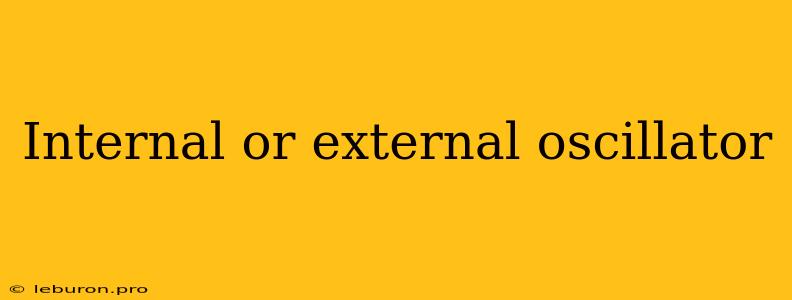The selection between an internal or external oscillator for a microcontroller or other embedded system is a crucial decision that impacts the design's performance, cost, and overall functionality. Each type of oscillator offers distinct advantages and disadvantages, and the choice ultimately depends on the specific application requirements. This article will delve into the intricacies of internal and external oscillators, exploring their characteristics, applications, and considerations for making the optimal choice for your project.
Internal Oscillators
Internal oscillators are integrated directly onto the microcontroller chip, eliminating the need for external components. They are typically crystal-based oscillators, which use a piezoelectric crystal to generate a precise frequency. The frequency is determined by the size and shape of the crystal and is often chosen to be a multiple of the microcontroller's clock frequency.
Advantages of Internal Oscillators
- Cost-effectiveness: Internal oscillators are inherently less expensive than external ones because they don't require additional components or board space.
- Simplicity: Using an internal oscillator simplifies the design process as it eliminates the need for external circuitry and connections.
- Space savings: The integration of the oscillator within the microcontroller saves valuable board space.
- Low power consumption: Internal oscillators generally consume less power than external oscillators due to their integrated nature.
Disadvantages of Internal Oscillators
- Limited frequency range: The frequency of an internal oscillator is typically fixed and often limited to a few options.
- Lower accuracy: Internal oscillators generally have lower accuracy and stability compared to external oscillators.
- Sensitivity to temperature and voltage fluctuations: The frequency of an internal oscillator can be affected by changes in temperature and voltage.
External Oscillators
External oscillators are separate components that are connected to the microcontroller via pins. They provide a more precise and stable frequency output than internal oscillators, making them suitable for applications where timing accuracy is critical. Common types of external oscillators include:
- Crystal oscillators: These oscillators use a piezoelectric crystal to generate a stable and precise frequency. They are widely used in high-performance applications that demand accuracy.
- Ceramic resonators: These oscillators are less expensive than crystal oscillators but also less accurate. They are often used in applications where accuracy is not critical.
- Clock generators: These oscillators offer more advanced features such as multiple output frequencies, adjustable frequency settings, and clock synchronization capabilities.
Advantages of External Oscillators
- Wide frequency range: External oscillators are available in a wide range of frequencies, providing greater flexibility in choosing the desired operating frequency.
- Higher accuracy and stability: External oscillators offer significantly higher accuracy and stability compared to internal oscillators.
- Less susceptibility to environmental factors: They are less sensitive to temperature and voltage variations.
Disadvantages of External Oscillators
- Higher cost: External oscillators are more expensive than internal oscillators due to the additional components.
- Complexity: They require external circuitry and connections, which can add complexity to the design.
- Increased board space: External oscillators take up additional board space.
- Potential for EMI/RFI: The external oscillator's circuit can contribute to electromagnetic interference (EMI) or radio frequency interference (RFI).
Factors to Consider When Choosing an Oscillator
- Accuracy requirements: For applications where timing accuracy is critical, such as real-time systems, communication protocols, and precision measurement, an external oscillator with high accuracy and stability is recommended.
- Frequency range: The required operating frequency of the system should be within the range of the chosen oscillator.
- Power consumption: For battery-powered devices or applications where power consumption is critical, internal oscillators are generally more efficient.
- Cost: The cost of the oscillator, including the component itself and any external circuitry, should be considered.
- Board space limitations: If board space is limited, an internal oscillator might be the better choice.
- Environmental conditions: The chosen oscillator should be able to withstand the expected environmental conditions, such as temperature variations and voltage fluctuations.
Applications of Internal and External Oscillators
- Internal oscillators: These are commonly used in low-cost, low-power applications such as basic embedded systems, consumer electronics, and simple microcontroller-based projects where accuracy is not a primary concern.
- External oscillators: These are often used in high-performance applications such as communication systems, data acquisition systems, industrial control systems, and medical devices where timing accuracy is critical.
Conclusion
The choice between an internal or external oscillator depends on the specific requirements of the application. For cost-sensitive, low-performance applications, an internal oscillator offers a simple and affordable solution. However, for high-performance applications demanding high accuracy and stability, an external oscillator is the preferred choice. By carefully considering the factors outlined in this article, designers can make an informed decision to optimize the performance, cost, and functionality of their embedded systems.
